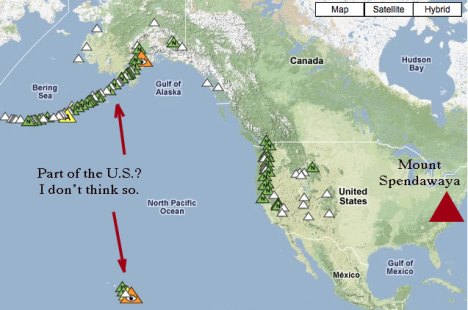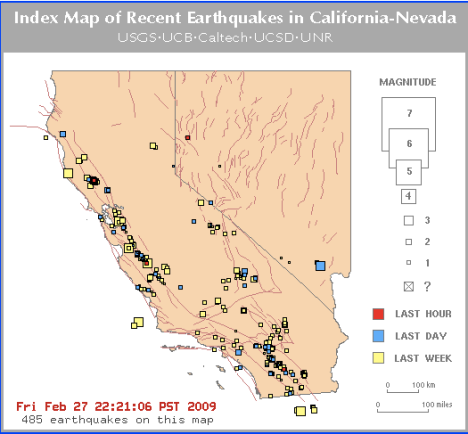Imagine, for a moment, if we could go back to 2000, during the lead-up to the reauthorization of the Elementary and Secondary Education Act of 1965, when many conservative lawmakers, intellectuals, and others who have no ‘business’ meddling in public education, were calling for reforms to model America’s education system after private industry. No Child Left Behind, did, in fact, include some of this business-like mentality with its emphasis on ‘products’, ‘quantifiable results’, and ‘accountability’, as well as a degree of privatization. But it could have been worse.
Senate Approves Massive Bailout for Education
Fake News 10-7-08
by Luke Laurie
The U.S. Senate today approved a $700 billion bailout of America’s education system, following seven years of corruption, mismanagement, and lack of regulation of the nation’s principle means of transmitting culture. Congressional investigators have attributed the collapse to the wholesale privatization of public schools and education services, and the increased use of a business model for school management.
Teachers Have Lost Their Voice
While teachers and liberal lawmakers have, for years, called for a return to public education, the powerful Education Reform Lobby has held a tight grip on Congressional appropriators and thwarted any intrusion by government regulators. Secretary of Education Bill Gates blamed the fallout on the handful of schools who refused to purchase Microsoft software, and suggested that schools sticking with Apple or Linux were the cause of the recent collapse. SInce the “Silence the Special Interests Act of 2002,” teachers’ unions and other advocacy groups have been unable to influence public policy. This measure limited lobbying access by establishing a rigid ‘pay to play’ principle that has limited congressional access to only the largest private conglomerations. In addition, the number of unionized teachers has greatly dwindled due to union-busting measures at the local, state and federal level.
Reform for Profit
In the early years of the “Bottom-Line for Schools Act of 2001”, the so called BS Act, everyone was a genius. Schools were encouraged to pursue a growth model akin to the tech startups of the 1990’s. Using leveraged capital provided by school vouchers, private companies created schools and networks of schools with lofty names that promised impossible services for little or no cost, and watched their stock prices skyrocket on speculation. These schools took many forms, and often resembled private religious schools, alternative charter schools, and academies of various kinds. They often touted emphasis in a particular industry or technical field, or sought to reinforce certain ideological or religious perspectives. The movement saw the creation of the Advanced Circuitry Kinder Lab, The Huffington School of Right is Wrong, Young Earth Youth Academy, and the A is A Ayn Rand School of Engineering and Architecture.
A Shining School on a Hill
Capitalized by inflated stock prices, fueled by speculation and day-traders, these new schools saw incredible growth, and were praised for success. States received massive bonuses and an influx of cash from the federal government for large-scale educational overhauls that were outsourced, often to fly-by-night contractors and textbook publishers, who took over all aspects of education, including everything from developing standardized tests to operating school buses. Glassy skyscrapers popped up in suburbs across America, the “District Offices” of the new education economy. Even Halliburton, a long-time military and energy services contractor, stepped in with their new Freedom Schools division. It was not unheard of to find the new school CEO’s showing up at D.C. cocktail parties.
A Break with Tradition
Perhaps the most damaging aspects of the movement were the wholesale abandonment of public facilities, practices, and personnel. In 2002, James D. Oldenfeller, Assistant Secretary of Education said, “States just don’t have the capacity to run schools the way that private industry does.” Oldenfeller left the administration that same year to oversee Halliburton’s Freedom Schools division. State and local governments relieved themselves of debt and balanced their budgets by selling school infrastructure to private contractors at discounted prices, receiving incentives from the Fed to do so. Some districts literally auctioned off desks, chairs, and even entire schools on Ebay.
Change for Change’s Sake
New startup schools were so heavily pressured to be different, that many school leaders professed that no long-standing educational practice could be continued. Schools abandoned antiquated methods of teaching reading, spelling, mathematics, history, and science. They scoffed at traditions like recess, summer vacation, and tenure for teachers. They embraced controversial new approaches like the “copy from Wikipedia” essay strategy, the “Yes you can use a calculator” computation method, and “Metaphysical Education- developing the mind and body without leaving your seat.”
“We need results, and we need them now,” Said President Bush in his State of the Union Address of 2002. “Like CEO’s on Wallstreet, schools need to be accountable. America can’t wait around for all this touchy-feely stuff to soak in. We need math and history, and math history. If our teachers can’t show results, then they’re not with us. If they’re not with us, they’re against us. If they’re against us, they’re with them. Who are them anyway?”
Goodbye Mr. Chips
The mass exodus of public school teachers, both forced and voluntary, is widely seen the most harmful result of the reform. Once considered the ‘core’ of education, the role of teacher was relegated to that of support personnel, number crunchers, script readers, and assembly workers on the educational factory floor. Disgusted, underpaid, and just plain fired for being too smarty-pants, career teachers were cast aside in favor of short-term ‘corps’-style teachers, who spent a few years in classrooms to erase college debts from overpriced universities.
Monetary rewards and penalties were applied to schools and teachers based on standardized test scores in Mathematics and Language Arts. Teacher pay was integrally tied to abstract quantitative data. Veteran teachers learned that their years of experience weren’t worth anything if they didn’t show up in the annual results. A massive redistribution of educational funding resulted, bringing even more State and Federal funds to the haves, and even less to the have-nots. Consequently, advanced placement classes and schools serving high income students became prized places of employment, and only people desperately needing work would take classes in low-income neighborhoods, or serving English Language Learners. In many-low income schools, undocumented immigrants were the only people willing to take the low paying, menial jobs as teachers.
To Good to be True
It wasn’t until the civil suit Rodriguez vs. LearnFunCorp.com (2007) was heard before the U.S. Supreme Court, that many of the problems of privatized education received national attention. The suit, brought by Jose Rodriguez, a 3rd grade student from Costa Verde, California, revealed that many students across the Country were no longer even going to school, and yet the companies that were responsible for educating them still had them on the books, and still cashed their vouchers.
LearnFunCorp.com calls itself a ‘virtual school,’ with no real classrooms or schools, no teachers, and no desks. Students enrolled in its programs must log on to their website, where they engage in “interactive educational video games” pioneered by Senator Joe Lieberman. Student questions submitted online or over the phone, are routed to a call center in Bengal, India. With it’s headquarters listed as a P.O. Box in Bermuda, and only a smattering of employees in the U.S., LearnFunCorp.com has paid no Federal taxes since it was established in 2002, though it has had more than $300 million in profits. In fact, according to investigative journalism by this publication, LearnFunCorp.com is virtually non-existent.
The Supreme Court case revealed that Jose Rodriguez had been a student enrolled in a virtual class with LearnFunCorp.com since he was five years old, and yet, had never received any educational services. His parents had signed forms to enroll Jose in virtual school, unaware of the significance of the decision, but they had no internet access, and had been unable to connect to the virtual environment. Calls to the Bengal call center to un-enroll Jose had proved useless. Local schools would not accept Jose into their classes, because his vouchers were already being received by LearnFunCorp.com. The case also revealed how ineffective the virtual learning environments were for young learners, with hundreds of young students still unable to read. While the case drew attention to these issues, it was tossed out by the highly conservative court.
A Problem Becomes a Crisis
In 2007, 4 out of 5 Americans believed that the education system had reached its lowest point in history, yet only 4 out of 10 thought something should be done about it. Conservatives praised the innovations of the education industry, and insisted the fundamentals of the education sector were strong. Liberals complained that public education should be restored in full, but couldn’t garner enough support to back a major initiative.
“We cannot, should not, play the market with the future of America,” said liberal Democrat Dennis Kucinich. “Privatization and outsourcing of America’s most treasured institution is simply unacceptable. In business, there are no profits without risk. Risk should play no part in an institution that we need to be consistently strong to maintain our national security, our culture, and our economy. We are violating the Constitutional rights of citizens when we deny anyone the full opportunity to be an active participant in our Democracy. ”
In 2004, the Federal government raised the stakes on test scores created pressure for schools to exceed their previous performance. Said one Freedom Schools official, “At first, we couldn’t go wrong. Our growth targets were so low, you could phone it in and still meet your goals. We lobbied the state to mandate only 1st grade mathematics and reading for high school graduation proficiency. But with the mandated goal of reaching 100% proficiency by 2013, those standards were too high.”
As a result, many schools began to use unconventional methods for gaming the system and cooking the books, so as not to lose their all-important vouchers and subsidies. Some schools encouraged students to be absent on testing days. Others transferred students from one school to another, to minimize the impact of ‘damaging’ demographic subgroups such as children from low-income families, English language learners, and special needs students. Racial tensions escalated in one Alabama town when all African American students were expelled on the same day, right before testing. Virtual schools simply did not report on the progress of low-performing students.
Luke Laurie is a teacher in Santa Maria, CA. “Sure test scores were rising. We were only teaching two subjects- Math and Language Arts. The school was transformed from a place of developing life-long learners into a corral for rote math and reading. All resources were diverted to target the kids on the cusp. Art, science, music, many of the things that matter most to people, were cut back or outright eliminated. Even with gaming the system, we reached our limits.”
Communities in Illinois became suspect when dozens of youth were loitering around the local 7-11 and the shopping malls during school hours, in a community that was reporting a 100% graduation rate. Freedom Schools, which ran the local school system, had been purging ‘low margin’ students from the rolls, by listing the students as ‘transfer: destination unknown.’
Even schools serving wealthy communities felt the effects of fraud and mismanagement. One Beverly Hills school, which always had outstanding test scores, paid 450 dollars each year for each student, for a consumable workbook on environmental education. The publisher had attained exclusive rights for environmental education, so the school claimed they had no other choice but to buy the book. The FBI determined that one school official had received a yacht and a remodel on his home in exchange for adopting the controversial text.
These tactics were concealed from investors, who had sunk billions into the fledgling industry. Education futures commodities had become highly leveraged, and repackaged into secondary and tertiary instruments, which were subsequently traded. The true value of these commodities is unknown. When the test scores were rising on a logarithmic scale, so were profits. The market was in denial that this growth would ever stop, and few realized how illusory the growth was to begin with. Now that the game is up, panic over the uncertain value of the packaged education futures has led to a selloff in markets worldwide.
A Bailout is Necessary
With the assets of dozens of education providers being seized by government regulators this week, and schools being shuttered across America, it is clear that the privatization movement has come to an end. Local communities are struggling with how to educate youth, when they no longer have public school facilities and teachers. Virtual school websites are now showing 404 errors ‘server not found.’ In a desperate move, Congress acted to bailout the private education providers with a $700 billion package, designed to recapitalize the struggling education companies, like Freedom Schools. “They’re just too big to fail,” said House Democrat Barney Frank.
The House Republican Study Committee issued the following statement yesterday: “It is the opinion of House Republicans that education is the cornerstone of American culture, and that only the free market can truly deliver the high quality education that Americans deserve. A few bad apples in the education sector have led us to this necessary and prudent bailout. Though we believe the cost of the bailout is an unfair burden for taxpayers, we reluctantly support the measure and encourage its passage.”
It is unclear if the bailout will work.
Filed under: Economics, Education, humor, Policy | Tagged: bailout, business, Economics, Education, humor, money, nclb, Policy, schools | Leave a comment »









